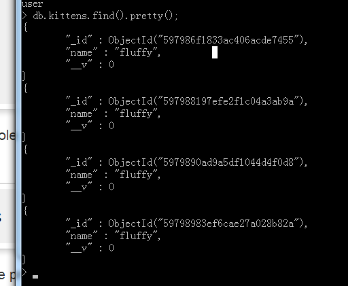Node.Js and Mongoose
Mongoose官方API,我做完之后整理出来的心得。
ONE· Getting Started
First be sure you have MongoDB and Node.js installed.
Next install Mongoose from the command line using npm:
$ npm install mongoose

项目中添加 mongoose模块
Now say we like fuzzy kittens and want to record every kitten we ever meet in MongoDB. The first thing we need to do is include mongoose in our project and open a connection to the test database on our locally running instance of MongoDB.
// getting-started.js
var mongoose = require('mongoose');
mongoose.connect('mongodb://localhost/test');

这里面运行官方的代码会有警告,查看原因之后,我进行了如下修改
var mongoose = require('mongoose');
mongoose.Promise = global.Promise;
mongoose.connect('mongodb://localhost/test',{useMongoClient:true});
We have a pending connection to the test database running on localhost. We now need to get notified if we connect successfully or if a connection error occurs:
var db = mongoose.connection;
db.on('error', console.error.bind(console, 'connection error:'));
db.once('open', function() {
// we're connected!
});
这里要注意,必须先开通mongodb的服务,node才能通过mongoose联通db
With Mongoose, everything is derived from a Schema. Let's get a reference to it and define our kittens.
var kittySchema = mongoose.Schema({
name: String
});
So far so good. We've got a schema with one property, name, which will be a String. The next step is compiling our schema into a Model.
var Kitten = mongoose.model('Kitten', kittySchema);
A model is a class with which we construct documents. In this case, each document will be a kitten with properties and behaviors as declared in our schema. Let's create a kitten document representing the little guy we just met on the sidewalk outside:
var silence = new Kitten({ name: 'Silence' });
console.log(silence.name); // 'Silence'
Kittens can meow, so let's take a look at how to add "speak" functionality to our documents:
// NOTE: methods must be added to the schema before compiling it with mongoose.model()
kittySchema.methods.speak = function () {
var greeting = this.name
? "Meow name is " + this.name
: "I don't have a name";
console.log(greeting);
}
var Kitten = mongoose.model('Kitten', kittySchema);
Functions added to the methods property of a schema get compiled into the Model prototype and exposed on each document instance:
var fluffy = new Kitten({ name: 'fluffy' });
fluffy.speak(); // "Meow name is fluffy"
We have talking kittens! But we still haven't saved anything to MongoDB. Each document can be saved to the database by calling its save method. The first argument to the callback will be an error if any occured.
fluffy.save(function (err, fluffy) {
if (err) return console.error(err);
fluffy.speak();
});

已经存进去了!
Say time goes by and we want to display all the kittens we've seen. We can access all of the kitten documents through our Kitten model.
Kitten.find(function (err, kittens) {
if (err) return console.error(err);
console.log(kittens);
})
We just logged all of the kittens in our db to the console. If we want to filter our kittens by name, Mongoose supports MongoDBs rich querying syntax.
Kitten.find({ name: /^fluff/ }, callback);
这里面用的是正则,也可以使用指定字段!
This performs a search for all documents with a name property that begins with "Fluff" and returns the result as an array of kittens to the callback.
Congratulations
That's the end of our quick start. We created a schema, added a custom document method, saved and queried kittens in MongoDB using Mongoose. Head over to the guide, or API docs for more.
TWO· 这个例子最新版本出现的警告和解决方案
第一个
https://segmentfault.com/q/1010000010061553/a-1020000010070929
mongoose.connect('mongodb://localhost/test',{useMongoClient:true});
第二个
http://blog.csdn.net/fd214333890/article/details/53486862
mongoose.Promise = global.Promise;


